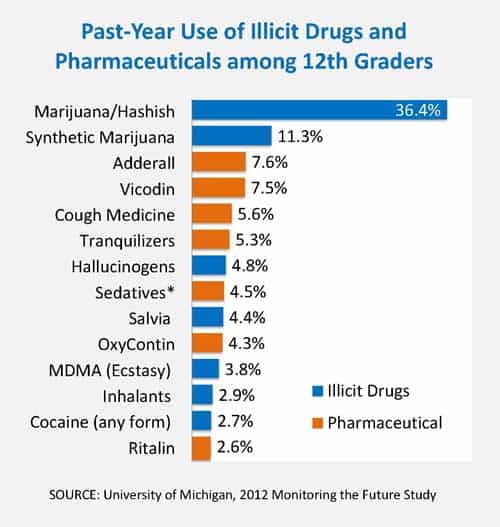An American national study that looked at hospital emergency department visits for opioid overdoses found that 67.8% of the cases involved overdosing on prescription opioid drugs, including methadone. Next in line were heroin, other unspecified opioids and multiple opioids. It’s estimated that the treatment costs for the hospitalized overdosed patients in 2010 alone was $2.3 billion.
Prescription drugs cause four times more opioid overdoses than heroin
Recreational use of prescription drugs is a serious problem with teens and young adults. National studies show that a teen is more likely to have abused a prescription drug than an illegal street drug. Actually, according to the National Institute on Drug Abuse an estimated 48 million people (aged 12 and older) have used prescription drugs for nonmedical reasons in their lifetime or roughly 20% of the US population. The three most commonly abused prescription drug classes are:
- Opioids used to treat pain
- Central nervous system (CNS) depressants, such as benzodiazepines (Xanax, Valium, Ativan, Klonopin), used to treat anxiety and sleep disorders
- Stimulants, such as Adderall or Ritalin, used to treat attention deficit disorder and narcolepsy (a sleep disorder)
A recent study made by researchers at Stanford University School of Medicine yet again highlights these disheartening statistics after it found an overwhelming majority of patients hospitalized for opioid overdoses used legally prescribed drugs. The researchers crunched the numbers from the 2010 Nationwide Emergency Department Sample and identified 135,971 weighted ED visits that were coded for opioid overdose. Of these 67.8 percent involved prescription opioids, followed by 16.1 percent heroin overdoses, while unspecified opioids and and multiple opioid types accounted for 13.4 percent and 2.7 percent of overdoses, respectively. The greatest proportion of prescription opioid overdoses happened in urban areas (84.1 percent), in the South (40.2 percent) and among women (53 percent).
[NOW READ] Painkiller addiction is the worst drug epidemic in US history
About 1.4 percent of patients who arrived in the ED eventually died of overdose and the authors suggest hospitals should ramp up their overdose emergency services. About half of the patients in the study sample who went to the ED for opioid overdoses were admitted to the hospital and costs for both inpatient and ED care totaled nearly $2.3 billion, according to the study published in JAMA Internal Medicine.
[INTERESTING] How a girl that doesn’t feel any pain might help create the painkillers of tomorrow
I think it’s important to get one thing straight, though. Some readers might get the impression after reading this article that prescription drugs are more dangerous than heroin, which is true in absolute numbers, but far from being true when accounting proportions. It’s estimated 0.2% of Americans use heroin, so heroin’s contribution to ER visits heavily outweighs painkillers.
“Opioid overdose exacts a significant financial and health care utilization burden on the U.S. health care system. Most patients in our sample overdosed on prescription opioids, suggesting that further efforts to stem the prescription opioid overdose epidemic are urgently needed,” the study concludes.











